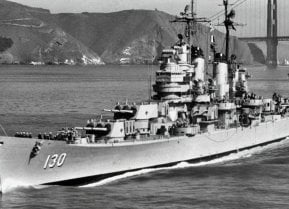Could You Merge an Aircraft Carrier and a Battleship?
In the 1980s, the U.S. considered converting four Iowa-class battleships into "battlecarriers," blending battleship firepower with aircraft carrier capabilities. The plan included adding a V-shaped flight deck and hangars to support up to twelve STOVL Harrier jets.
What You Need to Know: In the 1980s, the U.S. considered converting four Iowa-class battleships into "battlecarriers," blending battleship firepower with aircraft carrier capabilities. The plan included adding a V-shaped flight deck and hangars to support up to twelve STOVL Harrier jets.

-These WWII-era ships, renowned for their 16-inch guns and service in conflicts from WWII to the Gulf War, were also updated in 1982 with Tomahawk and Harpoon missiles.
-However, the plan to make them “battlecarriers” was abandoned as Cold War tensions eased, and all four Iowa-class battleships were eventually retired and repurposed as museum ships.
Why the U.S. Navy’s Battlecarrier Dream for Iowa-Class Battleships Was Scrapped
When the arms race between the U.S. and USSR during the Cold War was peaking, American engineers considered reactivating four World War II-era battleships to serve a new mission.
In the late 1970s, the Reagan Administration pushed to convert four Iowa-class battleships into “battlecarriers”- one-ship power projection force fitted with landing decks for short take-off vertical landing (STOVL) aircraft operations. Some thought ot the ideas a merging the a battleship into a sort of aircraft carrier hybrid.
This new Interdiction Assault Ship concept appeared attainable at the time. However, the dwindling of the arms race following the dissolution of the Soviet Union led to the class's scrapping altogether.
A brief history of the Iowa-class battleships:
Derived from the U.S. Navy’s War Plan Orange, the Iowa-class battleships were the last of their kind commissioned by the service during the Second World War. U.S. officials were concerned that its fleet of traditional 21-knot “standard-type” battleships would be outmatched by Japan’s counterparts in a kinetic conflict.
This worry, coupled with the “escalator clause” that allowed for greater displacement tonnage, culminated in the Iowa-class design. These ships were constructed to weigh 45,000 tons, rather than the previous 35,000-ton limit. Eight Babcock & Wilcox boilers and four sets of double-reduction cross-compound geared turbines powered the Iowa-class ships.
Specs & capabilities
While six Iowa battleships were ordered by the Navy in the late 1930’s, four vessels were completed- the Iowa, New Jersey, Missouri and Wisconsin.
Each of these vessels measured 860 feet in length with a maximum beam length of 108 feet. Armament-wise, each ship was equipped with nine 16-inch Mark 7 naval guns which could fire explosive and armor-piercing shells. Additionally, three-gun turrets positioned on each ship could launch any combination of its guns including a broadside of all nine.

Operational history and the beginning of the overhaul process:
Throughout their years in service, the Iowa-class ships participated in an array of combat operations. From the Pacific Theatre of World War II to Korea, Vietnam, Lebanon and Iraq, these battleships were well tested.
When the Iowa ships first reactivated in 1982, they were fitted with 16 Harpoon anti-ship missiles, 32 Tomahawk land attack cruise missiles and four Phalanx close-in weapons systems (CIWS) for defense.
Although this first phase of the class’ overhaul was approved, future proposals would not be carried out as seamlessly.
The proposal to modify these ships to become “battlecarriers” included significant modifications to the aft section.
As detailed by Task and Purpose, “A V-shaped ramped flight deck would be installed, with the base of the V on the ship’s stern. Each leg of the V would extend forward so that planes taking off would fly past the stacks and ship’s bridge. Two elevators would bring Boeing AV-8B Harrier II jump-jets up from a new hangar to the flight deck. It was envisioned that such a conversion could support up to twelve Harriers.”

No Battlecarrier for the U.S. Navy
Ultimately, the Iowa-class battleships never received the overhaul necessary to become the “battlecarriers” once dreamed up by the Reagan administration. Today, all four vessels are relegated to museum duty.
About the Author
Maya Carlin, National Security Writer with The National Interest, is an analyst with the Center for Security Policy and a former Anna Sobol Levy Fellow at IDC Herzliya in Israel. She has by-lines in many publications, including The National Interest, Jerusalem Post, and Times of Israel. You can follow her on Twitter: @MayaCarlin.
All images are Creative Commons.


